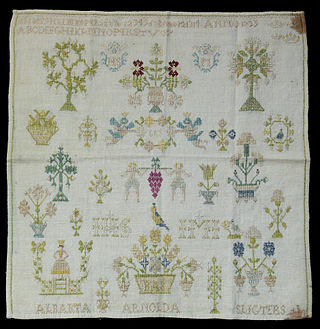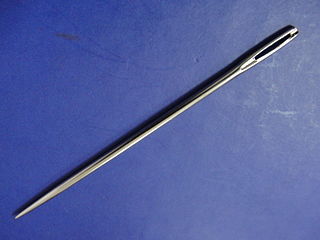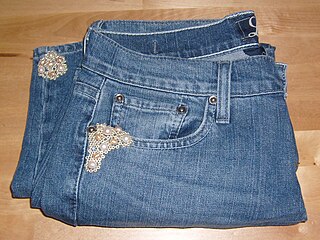Related Research Articles

Cross-stitch is a form of sewing and a popular form of counted-thread embroidery in which X-shaped stitches in a tiled, raster-like pattern are used to form a picture. The stitcher counts the threads on a piece of evenweave fabric in each direction so that the stitches are of uniform size and appearance. This form of cross-stitch is also called counted cross-stitch in order to distinguish it from other forms of cross-stitch. Sometimes cross-stitch is done on designs printed on the fabric ; the stitcher simply stitches over the printed pattern. Cross-stitch is often executed on easily countable fabric called aida cloth, whose weave creates a plainly visible grid of squares with holes for the needle at each corner.

Crochet is a process of creating textiles by using a crochet hook to interlock loops of yarn, thread, or strands of other materials. The name is derived from the French term crochet, which means 'hook'. Hooks can be made from different materials, sizes, and types. The key difference between crochet and knitting, beyond the implements used for their production, is that each stitch in crochet is completed before you begin the next one, while knitting keeps many stitches open at a time. Some variant forms of crochet, such as Tunisian crochet and Broomstick lace, do keep multiple crochet stitches open at a time.

Embroidery is the art of decorating fabric or other materials using a needle to stitch thread or yarn. Embroidery may also incorporate other materials such as pearls, beads, quills, and sequins. In modern days, embroidery is usually seen on hats, clothing, blankets, and handbags. Embroidery is available in a wide variety of thread or yarn colour. It is often used to personalize gifts or clothing items.

Knitting is a method for production of textile fabrics by interlacing yarn loops with loops of the same or other yarns. It is used to create many types of garments. Knitting may be done by hand or by machine.

Solar sails are a method of spacecraft propulsion using radiation pressure exerted by sunlight on large surfaces. A number of spaceflight missions to test solar propulsion and navigation have been proposed since the 1980s. The first spacecraft to make use of the technology was IKAROS, launched in 2010.

A hot air balloon is a lighter-than-air aircraft consisting of a bag, called an envelope, which contains heated air. Suspended beneath is a gondola or wicker basket, which carries passengers and a source of heat, in most cases an open flame caused by burning liquid propane. The heated air inside the envelope makes it buoyant, since it has a lower density than the colder air outside the envelope. As with all aircraft, hot air balloons cannot fly beyond the atmosphere. The envelope does not have to be sealed at the bottom, since the air inside the envelope is at about the same pressure as the surrounding air. In modern sport balloons the envelope is generally made from nylon fabric, and the inlet of the balloon is made from a fire-resistant material such as Nomex. Modern balloons have been made in many shapes, such as rocket ships and the shapes of various commercial products, though the traditional shape is used for most non-commercial and many commercial applications.

Hardanger embroidery or "Hardangersøm" is a form of embroidery traditionally worked with white thread on white even-weave linen or cloth, using counted thread and drawn thread work techniques. It is sometimes called whitework embroidery.

Chain stitch is a sewing and embroidery technique in which a series of looped stitches form a chain-like pattern. Chain stitch is an ancient craft – examples of surviving Chinese chain stitch embroidery worked in silk thread have been dated to the Warring States period. Handmade chain stitch embroidery does not require that the needle pass through more than one layer of fabric. For this reason the stitch is an effective surface embellishment near seams on finished fabric. Because chain stitches can form flowing, curved lines, they are used in many surface embroidery styles that mimic "drawing" in thread.

The AGM-154 Joint Standoff Weapon (JSOW) is a glide bomb that resulted from a joint venture between the United States Navy and Air Force to deploy a standardized medium-range precision-guided weapon, especially for engagement of defended targets from outside the range of standard anti-aircraft defenses, thereby increasing aircraft survivability and minimizing friendly losses. It is intended to be used against soft targets such as parked aircraft, trucks, armored personnel carriers (APCs), and surface-to-air missile sites (SAMs). Prior to launch, it is given a destination through either a predesignated waypoint or a point marked through a targeting pod. It glides, using two wings that pop out for added lift, to the marked destination and dispenses submunitions in a short, roughly linear pattern. The designation of the Joint Standoff Weapon as an "air-to-ground missile" is a misnomer, as it is an unpowered bomb with guidance avionics, similar to the older GBU-15.

In everyday language, a stitch in the context of embroidery or hand-sewing is defined as the movement of the embroidery needle from the back of the fibre to the front side and back to the back side. The thread stroke on the front side produced by this is also called stitch. In the context of embroidery, an embroidery stitch means one or more stitches that are always executed in the same way, forming a figure. Embroidery stitches are also called stitches for short.

A sewing needle, used for hand-sewing, is a long slender tool with a pointed tip at one end and a hole to hold the sewing thread. The earliest needles were made of bone or wood; modern needles are manufactured from high carbon steel wire and are nickel- or 18K gold-plated for corrosion resistance. High-quality embroidery needles are plated with two-thirds platinum and one-third titanium alloy. Traditionally, needles have been kept in needle books or needlecases which have become objects of adornment. Sewing needles may also be kept in an étui, a small box that held needles and other items such as scissors, pencils and tweezers.

The B61 nuclear bomb is the primary thermonuclear gravity bomb in the United States Enduring Stockpile following the end of the Cold War. It is a low-to-intermediate yield strategic and tactical nuclear weapon featuring a two-stage radiation implosion design.

A type certificate signifies the airworthiness of a particular category of aircraft, according to its manufacturing design. Certification confirms that the aircraft of a new type intended for serial production is in compliance with applicable airworthiness requirements established by the national air law.

Warp knitting is defined as a loop-forming process in which the yarn is fed into the knitting zone, parallel to the fabric selvage. It forms vertical loops in one course and then moves diagonally to knit the next course. Thus the yarns zigzag from side to side along the length of the fabric. Each stitch in a course is made by many different yarns. Each stitch in one wale is made by several different yarns.

Double knitting is a form of hand knitting in which two fabrics are knitted simultaneously on one pair of needles. The fabrics may be inseparable, as in interlock knitted fabrics, or they can simply be two unconnected fabrics. In principle, an arbitrary number of fabrics can be knitted simultaneously on one pair of knitting needles with yarns, as long as one is careful.

An embroidered patch, also known as a cloth badge, is a piece of embroidery which is created by using a fabric backing and thread. The art of making embroidered patches is an old tradition and was done by hand. During the first half of the twentieth century they were commonly embroidered using a shiffli embroidery machine. High-speed, computerized machines have led to mass production.

The Lockheed Martin C-130J Super Hercules is an American four-engine turboprop military transport aircraft. The C-130J is a comprehensive update of the Lockheed C-130 Hercules, with new engines, flight deck, and other systems.

Bead embroidery is a type of beadwork that uses a needle and thread to stitch beads to a surface of fabric, suede, or leather.
Air Evac EMS, Inc., operating as Air Evac Lifeteam and sometimes called simply Air Evac, is an American helicopter emergency medical service (HEMS) or air ambulance provider headquartered in O'Fallon, Missouri. It is the largest subsidiary of Global Medical Response, though still considered an independent provider. It is also the largest membership-supported air ambulance service in the US operating helicopters from 140 bases in 15 states, mostly in the central and southern regions of the country. While primarily a HEMS provider, it also operates 2 fixed-wing aircraft in Missouri and Kentucky.

Textile stabilization is a conservation method for fiber and yarn-based cloth intended to mitigate damage, prevent degradation and preserve structural integrity. Stabilization is part of a broad set of techniques in the field of conservation and restoration of textiles typically undertaken by a specialist or textile conservator. Appropriate treatment is determined through risk assessment and close examination of a textile's characteristics and the nature of the damage. Organic and synthetic fibers become weak due to age, handling, and environmental exposure and display physical deterioration such as fraying, planar distortion, loss, and change in surface character. Treatment involves reinforcing tensile strength and reintegration of parts for aesthetic, functional, and historic preservation. Methods can include stitching, darning, reweaving, and the attachment of supports through overlays and underlays. Hand-sewing follows the mantra of “gently does it” using fine needles, supple yarns, and a light touch. Heavily damaged and fragile fabrics often require stabilization through adhesive consolidation, though this is less common. It is essential that conservators consider physical and chemical compatibility along with future treatability in choosing a stabilization technique.
References
- ↑ "Service Bulletin: Sail Life Extension and Condition Monitoring" (PDF). airborne.com.au. 2008-03-17. AirBorne Service Bulletin SB-7 Issue1. Retrieved 2024-09-19.
- ↑ "Bettsometer BETTS-001". Ekmpowershop2.com. Retrieved 2011-05-12.
- ↑ "Microlight Type Approval Data Sheets" (PDF). Archived from the original (PDF) on 2011-06-06. Retrieved 2011-05-12.
- ↑ "Archived copy" (PDF). Archived from the original (PDF) on 2011-07-21. Retrieved 2009-08-02.
{{cite web}}: CS1 maint: archived copy as title (link) - ↑ "Department Of Civil Aviation" (PDF) (in Greek). Archived from the original (PDF) on 2011-07-16. Retrieved 2011-05-12.